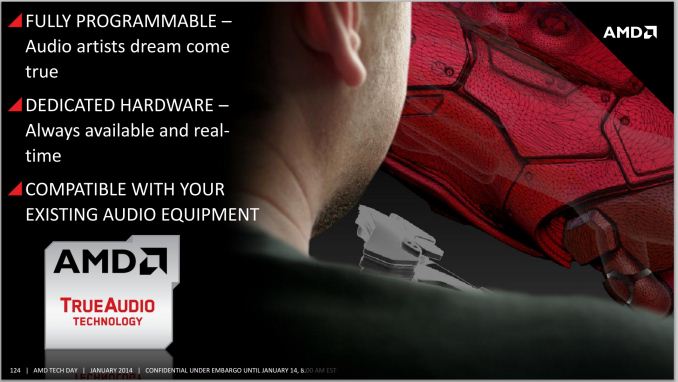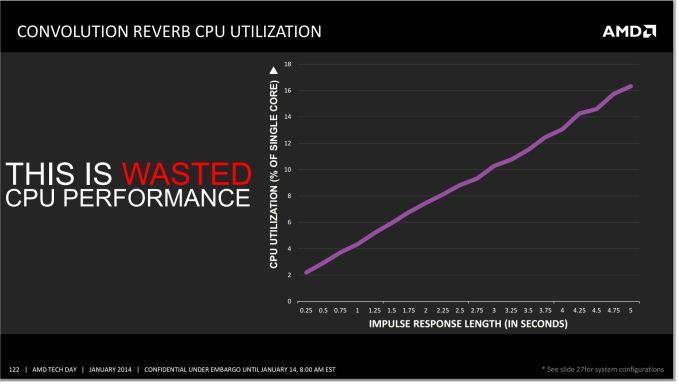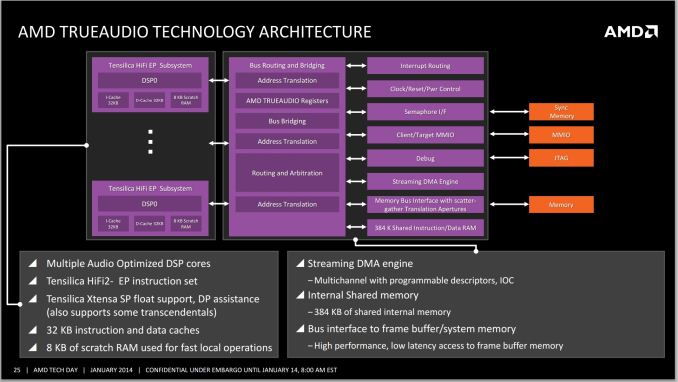AMD Kaveri Review: A8-7600 and A10-7850K Tested
by Ian Cutress & Rahul Garg on January 14, 2014 8:00 AM ESTTrueAudio
As part of the Kaveri package, AMD is also focusing on adding and updating their fixed function units / accelerators. Due to the jump on the GPU side to GCN we now have the TrueAudio DSP to allow developers to increase the audio capabilities in game, and both the Video Codec Engine (VCE) and Unified Video Decoder (UVD) have been updated.
All the major GPU manufacturers on the desktop side (AMD, NVIDIA, Intel) are pushing new technologies to help improve the experience of owning one of their products. There are clearly many ways to approach this – gaming, compute, content consumption, low power, high performance and so on. This is why we have seen feature like FreeSync, G-Sync, QuickSync, OpenCL adoption and the like become part of the fold in terms of these graphics solutions.
AMD’s new feature is TrueAudio - a fully programmable dedicated hardware element to offload audio tasks to.
The main problem with developing new tools comes down to whether they should be implemented in a general fashion or with a dedicated element. This comes down to the distinction of having a CPU or an ASIC do the work – if the type of work is specific and never changes, then an ASIC makes sense due to its small size, low power overhead and high throughput. A CPU wins out when the work is not clearly defined and it might change, so it opens up the realm of flexibility in exchange for performance per watt.
CPUs are now significantly powerful that a range of audio based techniques are available to them and the algorithms are optimized. The only limitation in this regard is the imagination of the developer or audio artist, which actually becomes part of the problem. When implementing an audio filter on the fly to a video game, the processing via the CPU can be overly taxing, especially when the effect is persistent over a long time. The example AMD gave in their press slide deck is one of adding reverb to an audio sample. The longer the reverb, the bigger the draw on CPU resources:
AMD cites this CPU usage as the effect of one filter on one audio sample. Imagine being in a firefight situation in a video game, whereby there are many people running around with multiple gunshots, splatter audio and explosions occurring. Implementing effects on all, and then transposing audio location to the position of the character is actually computationally expensive, all for the sake of realism. This is where the TrueAudio unit comes into play – the purpose is to offload all of this onto a dedicated bit of silicon that has the pathways built in for quicker calculations.
TrueAudio is also implemented on AMD's latest-generation R9 260 and R9 290 video cards – basically anything at least GCN 1.1 and up. Meanwhile we also know that the PS4’s audio DSP is based on TrueAudio, though given the insular nature of console development it's not clear whether the APIs are also the same on both platforms. AMD for their part is working with major audio middleware plugins (wwise, Bink) in order to help develop the TrueAudio ecosystem, so even in the case where the APIs are dissimilar, middleware developers can abstract that and focus on the similarities in the hardware underneath.
As is usually the case for these additional hardware features, games will need to specifically be coded to use TrueAudio, and as such the benefits of TrueAudio will be game specific. At the same time there are not any games currently on the market that can take advantage of the feature, so the hardware is arriving before there is software ready to use it. The first three games on AMD's list that will support TrueAudio are Murdered: Soul Suspect, Thief, and Lichdom. Much like FreeSync, I expect the proof is in the pudding and we will have to wait to see how it can affect the immersion factor of these titles.
Unified Video Decoder and Video Codec Engine
I wanted to include some talk about the UVD and VCE with Kaveri as both are updated – we get UVD 4, an update to error resiliency for H.264, and VCE 2, as shown below:
Of the two blocks, the improved VCE has the more interesting improvements to discuss. With the addition of support for B frames in H.264 encoding, the resulting ability to do backwards frame prediction should help improve the resulting image quality from VCE and/or reduce the required bitrates for any given quality level. Meanwhile the addition of support for the higher quality YUV444 color space in the H.264 encoder should help with the compression of primarily linear lineart/text, which in turn is important for the clarity of wireless displays.





















380 Comments
View All Comments
retrospooty - Tuesday, January 14, 2014 - link
"a low end cpu like the athlon X4 with a HD7750 will be considerably faster than any APU. So in this regard, I disagree with the conclusions that for low end gaming kaveri is the best solution."I get your point, but its not really a review issue , its a product issue. AMD certianly cant compete inthe CPU arena. They are good enough, but nowhere near Intel 2 generations ago (Sandy Bridge from 2011). They have a better integrated GPU, so in that sense its bte best integrated GPU, but as you mentioned, if you are into gaming, you can still get better performance on a budget by getting a budget add in card, so why bother with Kaveri?
Homeles - Tuesday, January 14, 2014 - link
"I get your point, but its not really a review issue , its a product issue."Well, the point of a review is to highlight whether or not a product is worth purchasing.
mikato - Wednesday, January 15, 2014 - link
I agree. He should have made analysis from the viewpoint of different computer purchasers. Just one paragraph would have worked, to fill in the blanks.. something like these -1. the gamer who will buy a pricier discrete GPU
2. the HTPC builder
3. the light gamer + office productivity home user
4. the purely office productivity type work person
just4U - Tuesday, January 14, 2014 - link
I can understand why he didn't use a 7750/70 with GDDR5 ... all sub $70 video cards I've seen come with ddr3. Your bucking up by spending that additional 30-60 bucks (sales not considered)Computer Bottleneck - Tuesday, January 14, 2014 - link
The R7 240 GDDR5 comes in at $49.99 AR---> http://www.newegg.com/Product/Product.aspx?Item=N8...So cheap Video cards can have GDDR5 at a low price point.
just4U - Tuesday, January 14, 2014 - link
That's a sale though.. it's a $90 card.. I mean sure if it becomes the new norm.. but that hasn't been the case for the past couple of years.ImSpartacus - Thursday, January 16, 2014 - link
Yeah, if you get aggressive with sales, you can get $70 7790s. That's a lot of GPU for not a lot of money.yankeeDDL - Tuesday, January 14, 2014 - link
Do you think that once HSA is supported in SW we can see some of the CPU gap reduced?I'd imagine that *if* some of the GPU power can be used to help on FP type of calculation, the boost could be noticeable. Thoughts?
thomascheng - Tuesday, January 14, 2014 - link
Yes, that is probably why the CPU floating point calculation isn't as strong, but we won't see that until developers use OpenCL and HSA. Most likely the big selling point in the immediate future (3 to 6 month) will be Mantle since it is already being implemented in games. HSA and OpenGL 2.0 are just starting to come out, so we will probably see more news on that 6 months from now with partial support in some application and full support after a year. If the APUs in the Playstation 4 and Xbox One are also HSA supported, we will see more games make use of it before general desktop applications.yankeeDDL - Tuesday, January 14, 2014 - link
Agreed. I do hope that the gaming consoles pave the way for more broad adoption of these new techniques. After all, gaming has been pushing most of the innovation for quite some time now.CPU improvement has been rather uneventful: I still use a PC with an Athlon II X2 @ 2.8GHz and with a decent graphic card is actually plenty good for most of the work. That's nearly a 5 year old CPU and I don't think there's a 2X improvement even going to a core i3. In any case, there have to be solution to improve IPC that go beyond some circuit optimization, and HSA seems promising. We'll all have to gain if it happens: it would be nice to have again some competition non the CPU side.